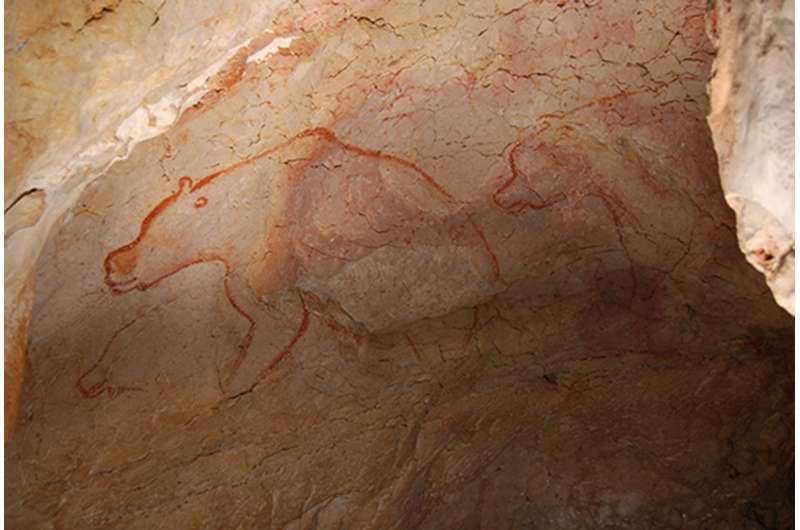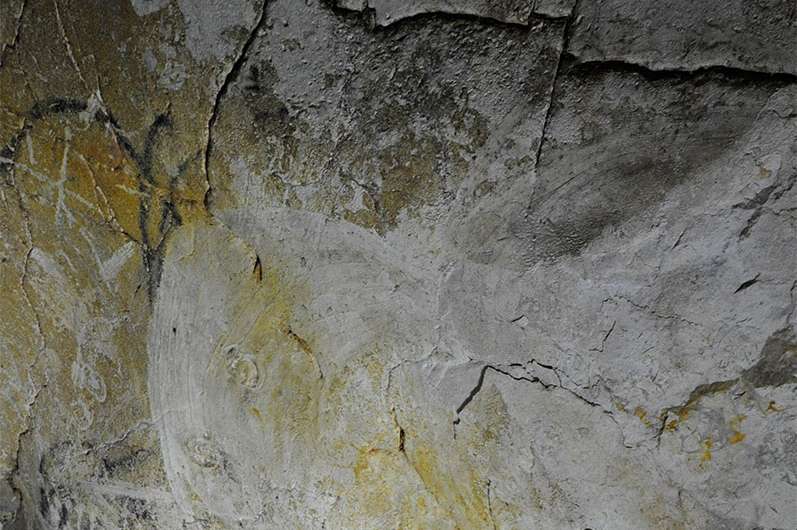April 12, 2016 report
Radio-carbon study suggests Chauvet-Pont d'Arc cave art much older than thought

(Phys.org)—A long-term study by an international team of researchers has led to findings that suggest drawings in the Chauvet-Pont d'Arc cave are approximately 10,000 years older than has been previously thought. In their paper published in Proceedings of the National Academy of Sciences, the team describes their study and the timeline of the cave they were able to build.
Chauvet-Pont d'Arc, in the Ardèche, southern France, has become famous for being the oldest known human decorated cave in the world. First discovered in 1994, the cave has since become a Unesco World Heritage Site—its walls are decorated with hand prints and drawings of 14 different species of animals including cave bears, wooly rhinos and several types of big cats. For many years, it was believed the cave paintings were made approximately 22,000–18,000 BC, now it appears the cave had a much longer and more varied history. In this new effort, the researchers used radio-carbon dating techniques on approximately 250 'objects' in the cave, over a span of 15 years. The objects included material used to draw animals, charcoal (from fires on the ground, in marks applied directly to the wall and from torch burns) and bones from an assortment of animals.
In analyzing the data, the researchers found they were able to create a time-line for the cave, which showed that it had been inhabited at least twice by early humans, and sometimes, by bears. They report that humans first inhabited the cave approximately 37,000 to 33,500 years ago and then again from 31,000 to 28,000 years ago. There was also evidence that bears had inhabited the cave for a time around 33,000 years ago, which coincides with human occupation, though the researchers do not believe both lived in the cave at the same time. Both species abandoned the cave due to dangerous rock slides—the second was strong enough to partially cover the opening to the cave, which likely accounts for no new occupations by either species in the ensuing years.
The new time-line suggests historians will have to push back the estimated time during which our ancestors first developed wall painting skills—those in the cave demonstrate a higher level of proficiency than was believed to have existed at the time.

More information: Anita Quiles et al. A high-precision chronological model for the decorated Upper Paleolithic cave of Chauvet-Pont d'Arc, Ardèche, France, Proceedings of the National Academy of Sciences (). DOI: 10.1073/pnas.1523158113
Abstract
Radiocarbon dates for the ancient drawings in the Chauvet-Pont d'Arc Cave revealed ages much older than expected. These early ages and nature of this Paleolithic art make this United Nations Educational, Scientific and Cultural Organization (UNESCO) site indisputably unique. A large, multidisciplinary dating program has recently mapped the anthropological evolution associated with the cave. More than 350 dates (by 14C, U-Th, TL and 36Cl) were obtained over the last 15 y. They include 259 radiocarbon dates, mainly related to the rock art and human activity in the cave. We present here more than 80 previously unpublished dates. All of the dates were integrated into a high-precision Bayesian model based on archaeological evidence to securely reconstruct the complete history of the Chauvet-Pont d'Arc Cave on an absolute timescale. It shows that there were two distinct periods of human activity in the cave, one from 37 to 33,500 y ago, and the other from 31 to 28,000 y ago. Cave bears also took refuge in the cave until 33,000 y ago.
Journal information: Proceedings of the National Academy of Sciences
© 2016 Phys.org



















